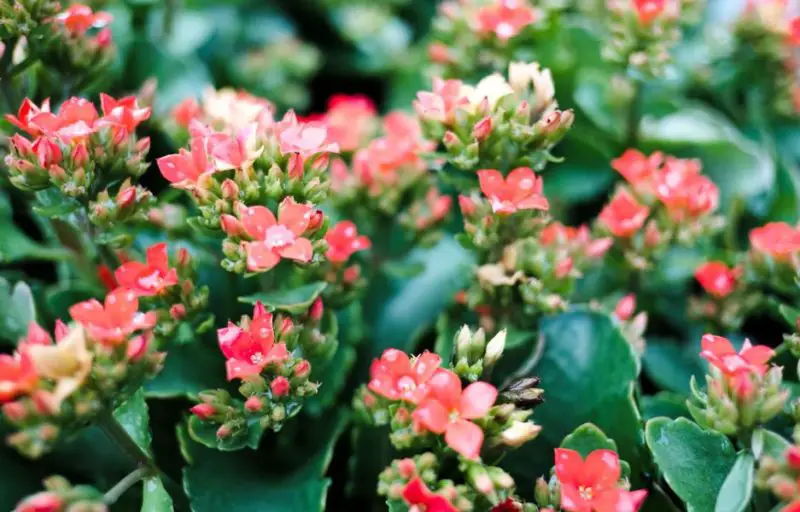Outdoor succulent plants offer a delightful blend of beauty and resilience, thriving in gardens, rockeries, and even hanging baskets. These hardy plants, known for their ability to withstand diverse climates, from arid deserts to temperate regions, bring a touch of natural elegance to any outdoor space.
In this guide, we’ll discuss everything you need to know about growing outdoor succulent plants, from choosing the right varieties to providing them with the care they need. We’ll also share some tips for designing beautiful succulent gardens that will make your neighbors green with envy.
Different Types of Outdoor Succulent Plants
String of Pearls

String of Pearls is a unique type of Senecio with round, succulent leaves that resemble pearls strung together on stems. This succulent thrives in direct or indirect sunlight and is well-suited for USDA Hardiness Zones 9-11. With its distinctive appearance and beautiful trailing habit, String of Pearls is an excellent choice for hanging baskets and high places, where its cascading stems can be showcased.
However, this plant is not suitable for ground cover. Its charming, pearl-like leaves make it a popular choice for adding a touch of elegance to various indoor and outdoor settings.
Euphorbia

Euphorbia almost looks like little Christmas trees, and for good reason—Poinsettias, often associated with Christmas, are a type of Euphorbia. This plant thrives in USDA Hardiness Zones 4–8 and prefers full to partial sun. Euphorbia can grow in mild climates and comes in many shapes, from cactus-like forms to more striking appearances. You can easily make Euphorbia the centerpiece of your garden or use it as a background plant.
With many species available and a familiar look, Euphorbia is adaptable to your garden’s needs, though it does not tolerate heat as well as other succulents.
Senecio

Senecio is a versatile plant genus with about 100 species, thriving in USDA Hardiness Zones 3–9 with indirect sunlight. Some popular and easily recognizable species include Blue Chalk and Fish Hooks. Despite being part of the Daisy family, Senecio can grow in a variety of environments, from gardens to hanging plants, thanks to its numerous species.
The adaptability of Senecio makes it a practical choice for many settings, offering dozens of species that can thrive in many environments. However, it cannot be placed in direct sun, which is a limitation to consider.
Sempervivum

Sempervivum is a popular succulent known for its ability to withstand cold, windy, and drought-prone environments. Thriving in USDA Hardiness Zones 4–9, it is suitable for many regions across the nation. Sempervivum requires sandy or gravelly soil, often paired with lava rock for improved drainage.
If adjusting your soil is not an option, growing Sempervivum in pots is a viable alternative. Its resilience in diverse environments makes it a hardy choice, but it does need ample drainage to thrive.
Kalanchoe

Kalanchoe is a versatile plant native to various regions, including America, Southeast Asia, and Africa. Thriving in USDA Hardiness Zones 10–12, it prefers bright, indirect sunlight and warm temperatures with minimal frost. This plant cannot tolerate frost but requires a moist environment.
Kalanchoe is admired for its attractive appearance, with species featuring smooth or felted leaves and vibrant flowers in colors such as pink, orange, yellow, red, and white. It can survive extreme heat, making it ideal for warm climates, though its inability to withstand cold or frost is a notable drawback.
Sedum

Sedum is a versatile succulent, thriving in USDA Hardiness Zones 3–11 under full sun. While not immediately associated with typical succulent appearances, Sedum is incredibly common outdoors. Its fleshy leaves and star-like small flowers contribute to its charm. Sedums are favored in gardens, especially rock gardens, where they provide texture and vibrant colors in a compact space.
They also excel in banks and come in various species—some trailing and petite, others large and upright. Their adaptability allows them to thrive in diverse conditions, though they require ample sunlight, which is essential to consider when planning their placement in gardens.
Graptopetalum

Graptopetalum, native to the southwestern United States and Mexico, thrives in USDA Hardiness Zones 7–11 under full sun. What sets this succulent apart is its ability to withstand some frost, with some varieties even recovering after exposure to temperatures as low as 20°F. Beyond its frost resistance, Graptopetalum charms with its flower-like appearance, often sporting fleshy leaves in shades of white or light gray with hints of pink and red.
Ideal for rock gardens as ground cover or in hanging planters for cascading effects, Graptopetalum offers versatility in garden design. Despite its resilience, it requires ample sunlight to thrive.
Haworthia

Haworthia, native to South Africa and thriving in USDA Hardiness Zones 9–11 with indirect sunlight, is renowned for its Zebra Plant variety, resembling Aloe Vera with its gel-filled leaves. Available in numerous species, the Zebra Plant stands out for its popularity, varying in size, color, and shape. Most Haworthia species prefer shade and mild climates, making them ideal for shady gardens.
However, they are susceptible to overwatering, which can quickly lead to their demise. Despite this vulnerability, Haworthia remains a favored choice among succulent enthusiasts for its diverse appearances and suitability for outdoor settings with ample indirect light.
Lithops

Lithops, also known as Living Stones, thrive in USDA Hardiness Zones 10–11 under full sun. These unusual succulents resemble stones with their flat, plump growth habit, making them well-suited to sunny locations.
Despite their slow growth rate and preference for small clusters over expansive coverage, Lithops excel in withstanding harsh sunlight and heat. They are prized for their unique appearance, making them ideal as accent pieces in gardens.
Dudleya

Dudleya, native to Baja California and the southwestern United States, thrives in USDA Hardiness Zones 9–12 under full sun. Resembling Echeveria in structure but with distinct colorations of green, purple, gray, and red, Dudleya boasts a flower-like shape that adds beauty to any garden setting.
Popular in rock gardens and sloped landscapes, Dudleya’s long stalks are known to attract hummingbirds, making it a versatile choice for various garden styles. However, it is less tolerant of cold temperatures and requires ample sunlight to flourish.
Echeveria

Echeveria, thriving in USDA Hardiness Zones 9–11 with partial, indirect sun, is celebrated for its exquisite beauty among succulents. Its intricate rosette or flower-shaped design comes in various striking colors like green, gray, pink, red, and white, all adorned with a green or green-gray hue.
With numerous species accounting for its color diversity, Echeveria is a versatile choice for gardens, particularly rock and zen gardens due to its aesthetic swirls and resilience. However, it requires careful placement as it does not tolerate direct sunlight or cold temperatures well.
Aeonium

Aeoniums, suited for USDA Hardiness Zones 9–11, display a distinctive rosette shape resembling flower petals, often in shades ranging from dark purple to brown with a contrasting center that fades from green to dark purple. These succulents thrive in full sun to partial shade and withstand intense heat, explaining their preference for hot climates.
However, they may go dormant during summer months. Aeoniums require well-drained soil and a sunny location to thrive, though they are sensitive to cold temperatures.
Crassula

Crassula, thriving in USDA Hardiness Zones 9–12 with partial shade, stands out among succulents for its unique appearance and ease of care. Unlike typical succulents, Crassula features dense foliage in vibrant shades of red and orange, adding a striking splash of color to any garden.
With numerous species available, ranging from varieties with branching stems to low-growing types, Crassula offers versatility to suit different garden spaces. However, it is sensitive to cold temperatures and requires protection during chilly weather.
Aloe

Aloe, thriving in USDA Hardiness Zones 8–11 under full sun, is cherished both indoors and outdoors for its ornamental value and medicinal benefits. Originating from the Mediterranean, Africa, and Madagascar, these succulents are known for their vibrant blooms in shades of orange, red, and yellow, which add a splash of color to any garden.
While some Aloe varieties stay compact in pots, others can grow tall, resembling small trees. Aloe Vera, the most recognized species, is widely used for its healing properties against sunburns. Despite its versatility and popularity, Aloe requires ample sunlight to thrive effectively.
Agave

Agave, thriving in USDA Hardiness Zones 5–11 under full sun, is among the most popular succulents native to the Americas. Known for their rapid and robust growth in the ground, Agave plants are recognizable by their large size and sword-shaped, smooth leaves.
With numerous varieties available, including the well-known Agave Americana and Queen Victoria Agave, there are ample options for cultivation. Most Agave species are characterized by their substantial size and straightforward maintenance. However, they require abundant sunlight and ample space to grow.
A Guide to Hardiness, Care, and Design for Outdoor Succulent Plants
Succulent plants have taken the gardening world by storm in recent years, and for good reason. These low-maintenance, drought-tolerant plants are easy to care for and come in a wide variety of shapes, sizes, and colors. They’re perfect for adding a touch of whimsy to any outdoor space, from container gardens to rock gardens to living walls.
If you’re thinking about adding outdoor succulent plants to your landscape, there are a few things you need to know to get started. First, it’s important to choose the right succulents for your climate. Some succulents are more cold-hardy than others, so it’s important to select varieties that can survive the winters in your area.
Once you’ve chosen your succulents, you’ll need to provide them with the right growing conditions. Succulents thrive in well-drained soil and full sun. They don’t need a lot of water, so it’s important to let them dry out between waterings.
With a little care, your outdoor succulent plants will thrive for years to come. They’re a great way to add color, texture, and interest to your landscape, and they’re sure to bring you joy for many years to come.






